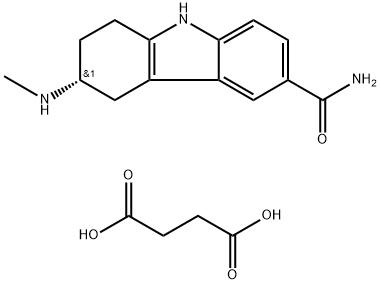158930-09-7
 158930-09-7 結(jié)構(gòu)式
158930-09-7 結(jié)構(gòu)式
基本信息
琥珀酸福伐曲坦
夫羅曲普坦琥珀酸鹽
琥珀酸福伐曲坦 1G
琥珀酸福伐曲坦(琥珀酸夫羅曲坦)
Sb-209509ax
FrovatriptanSuccinate
Fovatriptan succinate
(R)-3-(Methylamino)-2,3,4,9-tetrahydro-1H-carbazole-6-carboxamide succinate
(3R)-2,3,4,9-Tetrahydro-3-(methylamino)-1H-carbazole-6-carboxamide butanedioate
butanedioic acid,(6R)-6-(methylamino)-6,7,8,9-tetrahydro-5H-carbazole-3-carboxamide
1H-Carbazole-6-carboxamide, 2,3,4,9-tetrahydro-3-(methylamino)-, (R)-, butanedioate (1:1)
1H-Carbazole-6-carboxamide, 2,3,4,9-tetrahydro-3-(methylamino)-, (3R)-, butanedioate (1:1)
Butanedioic acid, compd. with (3R)-2,3,4,9-tetrahydro-3-(methylamino)-1H-carbazole-6-carboxamide (1:1)
物理化學(xué)性質(zhì)
| 報(bào)價(jià)日期 | 產(chǎn)品編號(hào) | 產(chǎn)品名稱 | CAS號(hào) | 包裝 | 價(jià)格 |
| 2024/11/08 | S5848 | 琥珀酸福伐曲坦 Frovatriptan Succinate | 158930-09-7 | 25mg | 877.11元 |
| 2024/11/08 | S5848 | Frovatriptan Succinate | 158930-09-7 | 1g | 10401.3元 |
常見問題列表
|
5-HT 1B Receptor 8.2 (pEC 50 ) |
5-HT 1D Receptor
|
Cerebral vasodilatation and neurogenic inflammation are considered to be prime movers in the pathogenesis of migraine. Activation of 5-HT 1B reverses cerebral vasodilatation and activation of 5-HT 1D prevents neurogenic inflammation. Frovatriptan has a high affinity for 5-HT 1B and 5-HT 1D receptors and a moderate affinity for the 5-HT 1A and 5-HT 1F receptors subtypes. Frovatriptan has a moderate affinity for the 5-HT 7 receptors, an action associated with coronary artery relaxation in the dog.
Oral bioavailability of Frovatriptan is 22%-30% and is not affected by food. Although the maximum concentration in the plasma is achieved in 2-3 hours, 60%-70% of this is achieved in 1 hour. A steady state is achieved in 4-5 days. Plasma protein binding is low at 15%. The most unique feature is the relative terminal long half-life of about 26 hours. Frovatriptan is chiefly metabolized by CYP1A2 and is cleared by the kidney and liver making moderate failure of either organ not a limiting factor in treatment.
Frovatriptan (0.1, 0.2, and 0.3 mg/kg; a single bolus intraduodenal administration) treatment produces an increase in carotid vascular resistance, which is sustained for at least 5 hours in dogs.